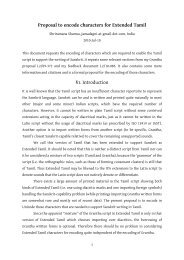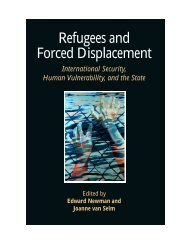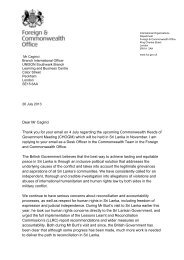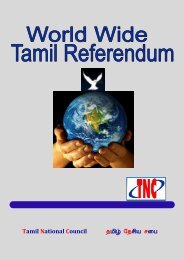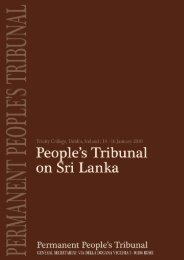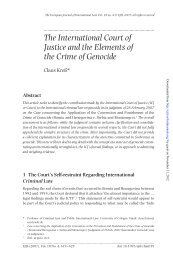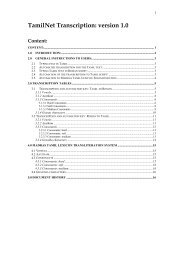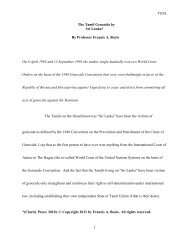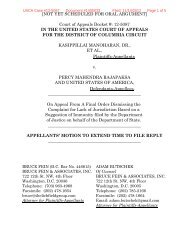Untitled - International Commission of Jurists
Untitled - International Commission of Jurists
Untitled - International Commission of Jurists
Create successful ePaper yourself
Turn your PDF publications into a flip-book with our unique Google optimized e-Paper software.
In the early 1970s, several judicial decisions validated executive actions restricting<br />
liberty rights during emergency in what was to be a troublesome precursor <strong>of</strong> things to<br />
come. 73<br />
3.2. The First Republican Constitution <strong>of</strong> 1972<br />
With the enactment <strong>of</strong> the First Republican Constitution in 1972, even the minimum<br />
guarantees <strong>of</strong> judicial independence in the 1948 Independence Constitution were<br />
swept away and the judiciary was openly subordinated to the political structures <strong>of</strong> the<br />
day. The National State Assembly was declared to be the sole and supreme repository<br />
<strong>of</strong> power. Article 3 stated that the judicial power <strong>of</strong> the people through courts and<br />
other institutions created by law may be exercised directly by the National State<br />
Assembly. The right <strong>of</strong> appeal to the Privy Council was done away and by Article<br />
122, the appointment <strong>of</strong> judges <strong>of</strong> the higher courts was vested in a non-elected<br />
President acting on the advice <strong>of</strong> the Prime Minister.<br />
The earlier Judicial Service <strong>Commission</strong> was replaced by a politicized Judicial<br />
Services Advisory Board (JSAB) and a weak Judicial Services Disciplinary Board<br />
(JSDB). The JSAB was not mandated to appoint judges <strong>of</strong> the minor courts but could<br />
merely recommend their names. The appointment was by the Cabinet <strong>of</strong> Ministers.<br />
The JSDB meanwhile exercised disciplinary control and dismissal <strong>of</strong> judges <strong>of</strong> the<br />
minor courts and state <strong>of</strong>ficers exercising judicial power but two members <strong>of</strong> this<br />
five-member commission were the Secretary to the Ministry <strong>of</strong> Justice and the<br />
Attorney General, thus effectively ensuring executive control over the judiciary.<br />
Even more significantly, judicial review <strong>of</strong> enacted laws was abolished. Instead, a<br />
Constitutional Court was established with the limited power to scrutinize bills within<br />
twenty-four hours when the bill was certified as being urgent in the national interest.<br />
The declaration <strong>of</strong> a state <strong>of</strong> emergency was allowed to be passed without a debate.<br />
Though the protection <strong>of</strong> specified rights was constitutionally declared, these<br />
provisions were rendered nugatory by the absence <strong>of</strong> an enforcement procedure. 74<br />
Clashes between the judiciary and the executive became common. Illustratively the<br />
judiciary and the Bar united to protest against “invitations” being sent out by the then<br />
Justice Minister Felix Dias Bandaranaike on the inauguration <strong>of</strong> a subordinated<br />
Supreme Court under the 1972 Constitution. The newly set up Constitutional Court<br />
clashed head-on at the first sitting <strong>of</strong> the Court over the Press Council Bill when the<br />
legislature decreed that the court had no discretion to give a liberal interpretation to a<br />
specified time limit within which to determine the constitutionality <strong>of</strong> the Bill. The<br />
entire court resigned and a fresh court had to be appointed.<br />
3.3. The Second Republican Constitution <strong>of</strong> 1978<br />
73 Hidramani v. Ratnavale, [1971] 75 NLR 67; Gunasekera v. Ratnavale, [1972] 76 NLR 316 - where<br />
the disallowing <strong>of</strong> a habeas corpus application against the Secretary <strong>of</strong> Defence was made all the more<br />
ironic by the fact that earlier, in Gunasekera v. De Fonseka ([1972] 75 NLR 246), a similar plea on<br />
behalf <strong>of</strong> the same corpus (but this time with the important distinction that it was made against a lower<br />
ranking Assistant Superintendent <strong>of</strong> Police) was judicially allowed on the basis that the police <strong>of</strong>ficer<br />
was not personally aware <strong>of</strong> the actual <strong>of</strong>fence <strong>of</strong> which the person arrested.<br />
74 Only a single case alleging violation <strong>of</strong> fundamental rights was filed during this time in the District<br />
Court, Ariyapala Guneratne v. The Peoples Bank, [1986] 1 Sri LR 338. This case was in fact decided<br />
after the 1972 Constitution was replaced by the 1978 Constitution.<br />
36



